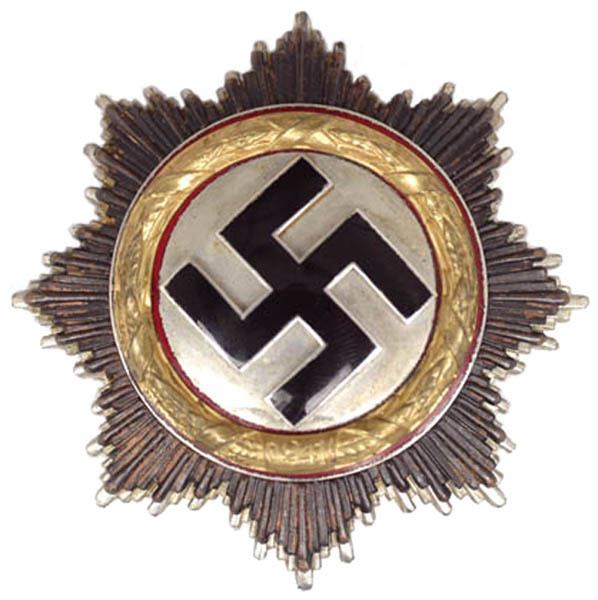Type Order Established 28 September 1941 | Eligibility Military personnel Status Obsolete | |
 | ||
Awarded for The Gold division was awarded to military personnel for 6–8 exceptional acts of bravery or achievements in combat. Silver division was awarded for distinguished acts of service in war effort. | ||
The German Cross (German: Deutsches Kreuz) was instituted by Adolf Hitler on 28 September 1941. It was awarded in two divisions: gold for repeated acts of bravery or achievement in combat; and silver for distinguished non-combat war service. The German Cross in Gold ranked higher than the Iron Cross First Class but below the Knight's Cross of the Iron Cross, while the German Cross in Silver ranked higher than the War Merit Cross First Class with Swords but below the Knight's Cross of the War Merit Cross with Swords.
Contents
Divisions
The German Cross was issued in two divisions: gold and silver (the color of the laurel wreath around the swastika), the former being an award for repeated acts of bravery or repeated outstanding achievements in combat, the latter being for multiple distinguished services in war efforts and was considered a continuation of the War Merit Cross with swords. The German Cross was unique in that the gold and silver divisions were considered as separate awards but were not to be worn simultaneously. However, pictures of recipients wearing both grades exist (see Odilo Globocnik and Dr. Paul Meixner).
Article three of the law governing the German Cross states that a prerequisite for the presentation of the German Cross in Gold or Silver is the ownership of the Iron Cross (1939) 1st Class or Clasp to the Iron Cross (1939) 1st Class, or the War Merit Cross 1st Class with Swords.
Appearance
The order consists of a star badge, containing a swastika (in German, Hakenkreuz, "hooked cross", which gives the award its name, the "German cross"). It had a diameter of 6.5 cm and was worn on the right-hand side of the tunic. If a recipient had been awarded both the silver and gold divisions, the gold division should be worn only.
Only the gold version of the award was officially available in cloth form, which was made for easier wear on the combat uniform; General Helmuth Weidling wore this variety during his defense of Berlin in April–May 1945. Far more awards in gold (combat) were presented than in silver (support).
Specimen copies of a special grade, the German Cross in Gold with Diamonds, was manufactured in 1942 but this grade was never instituted or bestowed.
1957 version
In 1957 alternative de-nazified replacement versions of the German Cross were authorized for wear by the Federal Republic of Germany. This replaced the swastika with a representation of the Iron Cross for the gold division, and the War Merit Cross with Swords for the silver division. Wearing Nazi-era decorations was banned in Germany after the war, as was any display of the swastika. The 1957 replacement of the World War II decorations consequently enabled recipients to wear the German Cross again but only in the new version of the insignia.
Of both divisions
Select recipients of both grades included:
Foreign recipients
Select foreign recipients of the German Cross in Gold included:
Some 26 non-German volunteers of the Waffen-SS from Belgium, Denmark, Estonia, Finland, Hungary, Latvia, Netherlands and Norway received the German Cross in Gold.
Nicknames
The German Cross was disparagingly referred to as "Hitler's fried egg" by Colonel Hans von Luck and other officers of his acquaintance, in response to its gaudiness. The extent to which this nickname was used is uncertain. It also been referred to in many history books as the "Nazi Party Badge for the near-sighted".
